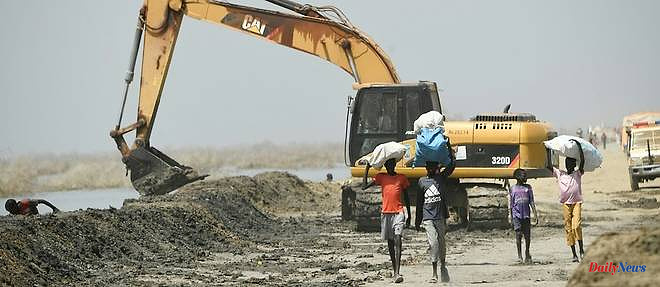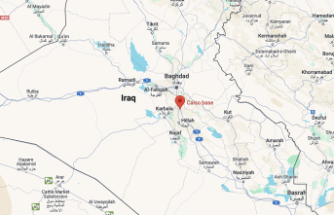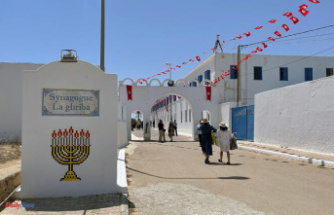It has been several months since there has been enough rain, but inexorably the floods continue in Bentiu, South Sudan, digging into the earthen fortifications that still stand between the abandoned and starving inhabitants and the water that pours in. stretches as far as the eye can see.
Four consecutive years of flooding, an unprecedented phenomenon linked to climate change, have inundated two-thirds of this landlocked country, but nowhere more dramatically than in Bentiu, a northern city besieged by the waters.
Hundreds of thousands of people are blocked, protected only by earthen dykes that must be constantly checked and reinforced to avoid a breach, which would be catastrophic.
The roads from Bentiu are flooded, even the one leading to neighboring Sudan, essential for transporting food to the capital of Unity State. Supplies are now trickling in, canoe by canoe.
"It's become an island," says William Nall, head of research, evaluation and surveillance at the World Food Program (WFP), which rations grain, vegetable oil and peanut paste that cross the rivers. filled with reeds.
The crisis illustrates a broader catastrophe hitting South Sudan, the youngest state on the planet and one of the most vulnerable to climate change.
A million people in this impoverished Nile Basin country have been affected since 2019 by floods that submerged an area larger than Denmark.
Millions of cattle have perished and 10% of the country's arable land has turned into swamps, while 7.7 million people do not have enough to eat.
Record rainfall on the Great Lakes of the upstream countries has accumulated huge volumes of water in the White Nile, spilling onto the plains downstream.
Large swathes of land became so saturated that water could no longer drain away. Even during the dry season, levels remained high, creating what William Nall calls "permanent wetlands", notably at Bentiu.
Experts say the decline could take several years. Even decades.
The floods represent an existential challenge for farmers and cattle herders, forced to flee to the cities.
"They don't know how to survive," said community leader John Both Wang as women in his flooded hamlet wait for food donations near a slum in Bentiu. "They don't want to be here. They want to go back."
But the earth is becoming more and more uninhabitable every day.
In January, at the height of the dry season, satellite images showed the area submerged by flooding had expanded by 3,000 square kilometers in a single week.
"People migrate every day. Today where you live is dry, but tomorrow it may be underwater," said Duop Yian, who grew up around Bentiu and works for the NGO Danish Refugee Council (DRC ).
Many arrive with nothing and join a population in need, already affected by the civil war that ravaged the country from 2013 to 2018.
Kuyar Teny waded through the waters to reach Bentiu with his starving 18-month-old grandson. "In the morning, he was always hungry and crying, but we had nothing to eat," she says while waiting to see a doctor. The child's hair, due to malnutrition, is now straw-colored.
During an AFP visit, a health clinic helping some 20,000 people had just 10 staff. In a tent, three women on IVs shared a single bed.
Oil deposits, the wealth of this country of 12 million inhabitants, are being explored near Bentiu. But it is the humanitarian organizations, not the authorities, that come to the aid of the local population.
Beyond the sandbags and dykes, a landscape of desolation stretches out.
Duop Yian points to a flooded area that used to be farmland and a road the children used to get to school. Now only the tips of thatched huts and water lilies remain, a last resort for those who are hungry, Yian said.
Some cling on, desperately trying to survive on the last remaining uplands.
A few hundred people live in Tong, about an hour's canoe ride from Bentiu, on a scattering of islands. They were still several thousand less than two years ago.
Among them is Magok Bangany, an 80-year-old farmer who was born and raised in the village. The octogenarian recalled a big flood, when he had just reached adulthood, "which lasted two years, then it receded. It was the worst I have seen", he confides, using a cane to remove the mud that sticks to his feet.
South Sudan suffers from seasonal flooding. But generally nothing of this magnitude, argues William Nall of the WFP. "We're all in uncharted territory here. It's so much bigger than the last such event," he said.
And population displacements also lead to clashes.
Herders took their cattle south and clashed with farmers over land and resources, the International Crisis Group reports.
The think tank warns that South Sudan "exemplifies the forms of climate-related instability and violence" that Africa could face without money from rich countries to adapt to global warming.
But donations are scarce. Aid has dwindled because of the war in Ukraine, which has also increased food prices, and the WFP has had to cut rations.
Families, struggling to survive on their monthly stipends, are often forced to eat wild flowers and fruits.
"We have been forgotten," said Tong resident Mary Nyaruay. "We have to fight to survive."
03/22/2023 08:32:06 - Bentiu (Soudan du Sud) (AFP) - © 2023 AFP












